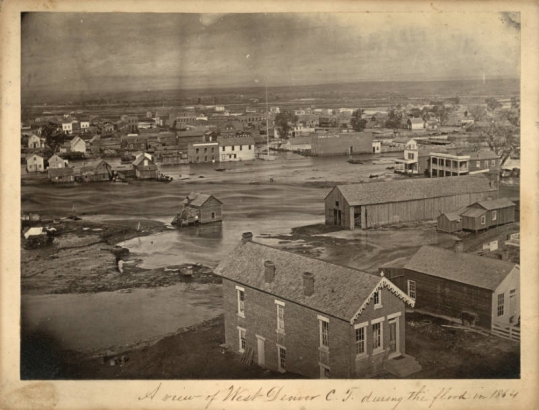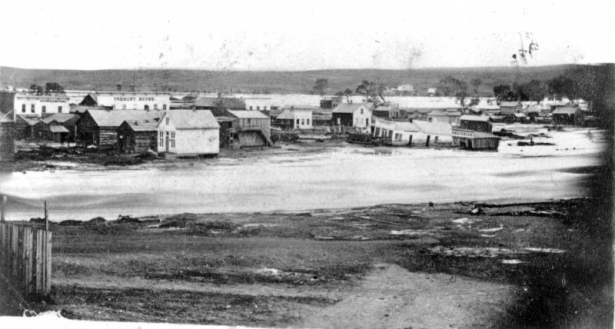On the night of May 19, 1864, the residents of the frontier town of Denver, Colorado Territory, went to sleep blissfully unaware of the fact that they were about to experience the city's first major flood. Swollen by days of rain, the waters of Cherry Creek and the Platte River overflowed their banks—taking an untold number of lives, millions of dollars of property, and irreplaceable city records.
The Great Flood of 1864 is described in some detail by seminal Denver historian Jerome Smiley in his 1901 book History of Denver. He says that the "old plainsmen and mountaineers" had been seeing signs of potential flooding in the form of swollen creeks and minor flash flooding, but Denverites ignored their warnings.
Smiley describes what happened next:
After midnight the creek suddenly became an angry roaring torrent that exercised its long-reserved powers of devastation without warning. It swept down upon and through the town like a besom of destruction; through the collection of dwellings, saloons and business establishments that stood directly in it its course, it tore its way, and daylight on the morning of the 20th revealed the extent of the mischief it had wrought.
To understand why "mischief" is such an understatement in this case, it's worth taking a look at what the Denver/Auraria area looked like in 1864. For starters, the two towns had only recently agreed to stop competing and come together as one city. According to Smiley, Auraria hosted more businesses (mainly saloons and gambling halls), while Denver had more residences. The bulk of civic life was clustered around Cherry Creek in what is, more or less, today's Larimer Square and the intersections of 16th Street, 17th Street, Market and Larimer Streets.
Although both sides of Cherry Creek were devastated by the raging waters, the Auraria side of the creek was crippled due to a lethal disadvantage—a much lower elevation. Auraria thus took the brunt of the raging floodwaters wrought on the pioneer town. The next morning, Auraria was still covered in several feet of water and some residents had to be rescued by boat.
At least eight people were known to have been killed in the flood, though the exact number was never known for certain —and Denverites weren't the only ones killed in the maelstrom. Smiley reports two separate incidences of women and children being swept to their deaths in the flood in Plum Creek and another group "some distance above the town." One lucky woman was pulled in the torrent, but somehow managed to pull herself out and was discovered a full eighteen miles downstream from Denver.
Historic losses felt to this day
Besides the cost in human lives and livelihoods, the City of Denver lost some irreplaceable history in the flood of 1864. Among the buildings that the flood took away was the "Old City Hall" on Blake Street near Cherry Creek. Smiley reports that one of the objects lost with the building was a safe containing the city's earliest land and municipal records; items which certainly would have been retained (maybe even by Denver Public Library) and would have proven very useful in adjudicating future Denver real estate battles.
Also lost in the flood was the original Rocky Mountain News building, which rested on stilts along the creek bed near Market Street. The paper lost thousands of dollars worth of property, along with the only copies of a few of its earliest issues. A brave RMN employee named John L. Dailey grabbed some cash and a few records from the building as it crumbled into the creek, but was lucky to escape with his life. A few years later, construction workers found pieces of the old Rocky's press buried beneath 15 feet of mud. Those pieces were retained by the Colorado Historical Society.
Although the city's buildings were thoroughly devastated by the flood, the people appear to have rebuilt without much fuss. After all, they were barely a year out from rebuilding from the Great Fire of 1864. No doubt businesses thought long and hard before building so close to Cherry Creek, and Auraria never really regained its pre-flood swagger. Cherry Creek and the South Platte River overflowed multiple times until the city finally got them under control, more or less, during Mayor Robert Speer's administration. But on the night of May 19, 1864, those two bodies of water showed the people of Denver that they were a long way from being tamed.



Comments
In the very last sentence
In the very last sentence date is 1863. Shouldn't that year be 1864 for The Great Flood?
In the very last sentence the
In the very last sentence the date is May 19,1863. Shouldn't the year be 1864 for The Great Flood?
Thank you so much for this!…
Thank you so much for this! I had thought I was going crazy. In fifth grade I remember learning that the RMN built their presses over Cherry Creek so that they wouldn't show favoritism to Auraria or Denver, but the flood washed it out. For decades I would say "Does anyone remember this?" And no one remembered it! Yay! I guess this means I wasn't actually sleeping through history class in 5th grade... thank you Mr. Nahickian.... :D
Add new comment